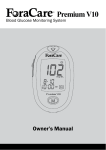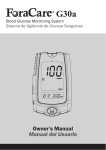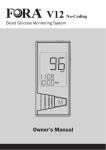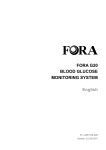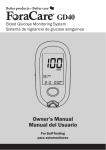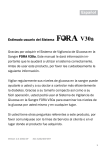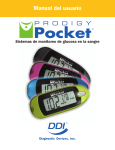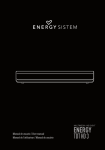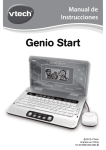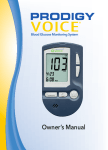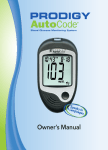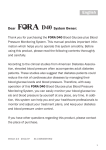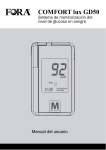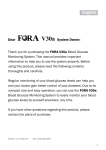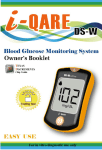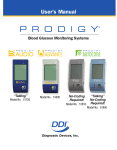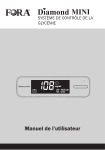Download Owner`s Manual Manual del Usuario
Transcript
Blood Glucose Monitoring System Sistema de Vigilancia de Glucosa Sanguinea Owner’s Manual Manual del Usuario English Dear Owner of ForaCareTest N’GO™ Blood Glucose Monitoring System: The system consists of three main products: the meter, test strips and control solutions. These products have been designed, tested, and proven to work together as a system to produce accurate blood glucose test results. Only use ForaCare Test N’GO™ test strips and control solutions with the ForaCare Test N’GO™ Blood Glucose Monitoring System. Version 1.0 2013/02 311-4283200-001 2 TABLE OF CONTENTS IMPORTANT SAFETY INSTRUCTIONS Read Before Use Important Information Intended Use Test Principle Appearance And Key Functions of The Meter Meter Display Test Strip Setting the Meter And Deleting the Memory 04 04 06 07 07 08 09 10 11 CHECKING THE SYSTEM WITH CONTROL SOLUTIONS How to Perform A Control Solution Test 14 14 TESTING YOUR BLOOD The Four Measuring Modes How to Perform A Blood Glucose Test Preparing the Puncture Site Performing A Blood Glucose Test 17 17 18 19 16 VIEWING THE METER MEMORY Viewing Results Viewing Day Average Results 23 23 24 DOWNLOADING RESULTS ONTO A COMPUTER 26 CLEANING AND DISINFECTING YOUR METER Caring for Your Meter Disinfecting Procedures 27 27 28 BATTERY RECHARGE 30 DISPLAY MESSAGES AND PROBLEM-SOLVING GUIDE Troubleshooting 31 33 DETAILED INFORMATION Reference Values 34 34 Comparing Meter and Laboratory Results SPECIFICATIONS Federal Communications Commision (FCC) Statement 34 36 37 3 IMPORTANT SAFETY INSTRUCTIONS Read Before Use ● The meter and lancing device are for single patient use. Do not share them with anyone including other family members! Do not use on multiple patients! ● All parts of the kit are considered biohazardous and can potentially transmit infectious diseases, even after you have performed cleaning and disinfection. For more information, please visit 1. FDA Public Health Notification: Use of Fingerstick Devices on More than One Person Poses Risk for Transmitting Bloodborne Pathogens: Initial Communication (2010) http://www.fda.gov/MedicalDevices/Safety/AlertsandNotices/ ucm224025.htm 2. CDC Clinical Reminder: Use of Fingerstick Devices on More than One Person Poses Risk for Transmitting Bloodborne Pathogens (2010) http://www.cdc.gov/injectionsafety/Fingerstick-DevicesBGM.html 4 1. Use this device ONLY for the intended use described in this manual. 2. Do NOT use accessories which are not specified by the manufacturer. 3. Do NOT use the device if it is not working properly or or if it is damaged. 4. Do NOT use the equipment in places where aerosol sprays are being used, or where oxygen is being administered. 5. This device does NOT serve as a cure for any symptoms or diseases. The data measured is for reference only. 6. Before using this device to test blood glucose, read all instructions thoroughly and practice the test. Carry out all the quality control checks as directed. 7. Keep the device and testing equipment away from young children. Small items such as the battery cover, batteries, test strips, lancets and vial caps are choking hazards. 8. Use of this device in a dry environment, especially if synthetic materials are present (synthetic clothing, carpets etc.) may cause damaging static discharges that may cause erroneous results. 9. Do NOT use this device in close proximity to sources of strong electromagnetic radiation, as these may interfere with the accurate operation. KEEP THESE INSTRUCTIONS IN A SAFE PLACE 5 Important Information • Severe dehydration and excessive water loss may cause readings which are lower than actual values. If you believe you are suffering from severe dehydration, consult a healthcare professional immediately. • If your blood glucose results are lower or higher than usual, and you do not have symptoms of illness, first repeat the test. If you have symptoms or continue to get results which are higher or lower than usual, follow the treatment advice of your healthcare professional. • Use only fresh whole blood samples to test your blood glucose. Using other substances will lead to inaccurate results. • If you are experiencing symptoms that are inconsistent with your blood glucose test results and you have followed all the instructions given in this owner s manual, contact your healthcare professional. • We do not recommend using this product on severely hypotensive individuals or patients who are in shock. Readings which are lower than actual values may occur for individuals in a hyperglycemic-hyperosmolar state, with or without ketosis. Please consult your healthcare professional before use. 6 Intended Use ForaCare Test N’GO™ Blood Glucose Monitoring System is intended for self testing outside the body (in vitro diagnostic use) by people with diabetes at home as an aid to monitoring the effectiveness of diabetes control. It is intended to be used for the quantitative measurement of glucose (sugar) in fresh capillary whole blood samples drawn from the fingertips. This system is intended for single-patient use (lay-users at home) and should not be shared. It should not be used for the diagnosis of or screening for diabetes mellitus, or testing on newborns. This system provides you with plasma equivalent results. Test Principle Your system measures the amount of sugar (glucose) in whole blood. The glucose testing is based on the measurement of electrical current generated by the reaction of glucose with the reagent of the strip. The meter measures the current, calculates the blood glucose level, and displays the result. The strength of the current produced by the reaction depends on the amount of glucose in the blood sample. NOTE: Check your system to ensure that it is unopened prior to use and that it contains all parts listed above. If anything is missing or damaged, please return your system to the place of purchase. 7 Appearance And Key Functions of The Meter 1 4 3 2 5 7 6 1 Display Screen 2 Test Slot 3 Main Button 4 Charging indicator/Bluetooth indicator 5 SET Button 6 Battery Cover 7 USB Port (only for charge) For battery recharge. NOTE: The meter will turn off automatically after 180 seconds without any action or you can press and hold the main button for 3 seconds to turn off the meter. 8 Meter Display 3 2 1 9 4 8 7 5 6 1 Error Message Symbol 2 Measurement Unit 3 Testing Result Display 4 5 6 Blood Drop Symbol Flashes when meter is ready for sample application. Measuring Mode 7 Time Display Gen, AC, PC, QC. 8 Alarm Symbol 9 Low Battery Symbol Memory Symbol Indicates a test result stored in memory. 9 Test Strip Your system measures the amount of sugar (glucose) in whole blood. Blood is applied to the absorbent hole on the test strip and is automatically drawn into the reaction cell where the reaction takes place. Absorbent Hole Apply a drop of blood here. The blood will be automatically absorbed. Test Strip Handle Hold this part to insert the test strip into the slot. 10 Confirmation Window This is where you confirm if enough blood has been applied to the absorbent hole in the strip. Contact Bars Insert this end of the test strip into the meter. Push it in firmly until it will go no further. Setting the Meter And Deleting the Memory Start with the meter off (no test strip inserted). Press SET. 1. Setting the date With the year flashing, press Main button until the correct year appears. Press SET. With the month flashing, press Main button until the correct month appears. Press SET. With the day flashing, press Main button until the correct day appears. Press SET. 2. Setting the time format Press Main button to select the desired time format --- 12h or 24h. Press SET. After you have finished selecting the 12h or 24h clock, press SET and then the hour will flash on the screen. 3. Set the hour and minute With the hour flashing, press Main button until the correct hour appears. Press SET. With the minute flashing, press Main button until the correct minute appears. Press SET. 11 4. Deleting the memory With dEL and a flashing on the display, press Main button and select no to keep the results in memory then press SET to skip. To delete all the results, press Main button and yes and are displayed on the meter, press SET to delete the memory. If you do not want to delete the results, do not press the Main button but press the SET button again to turn off the meter. 5. Set the reminder alarm You may set up any or all of the reminder alarms (1-4). The meter displays On or OFF and , press Main button to turn on or turn off to set the first reminder alarm. Press Main button to select On , then press SET to set the hour. When the hour is flashing, press Main button to add an hour. Press SET to confirm and go to minutes, press Main button to add one minute. Hold Main button longer to add 12 faster. Press SET to confirm and go to the next alarm setting. If you do not want to set an alarm, press SET to skip this step. If you want to turn off an alarm, find the alarm number by pressing SET in the setting mode, press Main button to change from ON to OFF . 6. Enter the Bluetooth pairing With the no symbol flashing on the display, press SET to skip the pairing. If you wish to enter the pairing mode, press Main button once and the meter will display yes . Then press SET to confirm and the meter will show CLr . The meter will then automatically turn off and the Bluetooth indicator will start blinking, which means the meter is in the process of pairing with a Bluetooth receiver. NOTE: This step is recommended when the user needs to pair this meter to a Bluetooth receiver for the first time, or when user needs to pair this meter to another new Bluetooth receiver. 13 CHECKING THE SYSTEM WITH CONTROL SOLUTIONS Our control solutions contain a known amount of glucose that reacts with test strips. By comparing the result of your control solution test with the expected range printed on the test strip vial label, you can check that the meter and the test strips are working together as a system and that you are performing the test correctly. It is very important that you perform this simple check routinely to make sure you get accurate results. Do a control solution test when: ● you first received the meter, ● at least once a week for routinely check the meter and test strips, ● you begin using a new vial of test strips, ● you suspect the meter or test strips are not working properly, ● your blood glucose test results are not consistent with how you feel, or if you think the results are not accurate, ● practicing the testing process, or ● you dropped or think you have damaged the meter. How to Perform A Control Solution Test Our control solutions contain a known amount of glucose that reacts with test strips and is used to ensure that the meter and test strips are working together correctly. Test strips, control solutions, or sterile lancets may not be included in the kit (please check the contents on your product box). They can be purchased separately. Please make sure you have all items prior to testing your blood glucose. Please contact the Customer Care Line at 1-866-469-2632 or the place of purchase for availability. 14 1. Insert test strip Insert a test strip into the test slot with the contact bars end first and facing up. (Contact bars must be inserted all the way into the meter or you may get an inaccurate test result.) The meter turns on automatically and displays the following in sequence: When the appears on the display, press the Main button and QC will appear on the display. When the QC sign is displayed, the meter will not store your test result in the memory. If you decide not to perform a control solution test, press the Main button again and the QC sign will disappear. CAUTION: Every time you perform a control solution test you must enter QC test mode so that the test result will not be stored in the meter memory. 15 2. Apply control solution Shake the control solution vial thoroughly before use. Squeeze out a drop and wipe it off, then squeeze out another drop and place it on the tip of the vial cap. Hold the meter to move the absorbent hole of the test strip to touch the drop. Once the confirmation window fills completely, the meter will begin counting down. To avoid contaminating the control solution, do not directly apply control solution onto a strip. 3. Read and compare the results After the meter counts to 0, the result of the control solution test will appear. Compare the result with the range printed on the test strip vial. The result should fall within this range. Out-of-range results If you continue to have test results fall outside the range printed on the test strip vial, the meter and strips may not be working properly. Do NOT test your blood. Contact the local customer service or place of purchase for help. 16 TESTING YOUR BLOOD Before testing, be sure to read this section and the test strip insert found in the test strip box carefully. Make sure you have all the items needed for the test. The Four Measuring Modes The meter provides you with four modes for measuring: General, AC, PC and QC. USE WHEN MODES General tests any time of day without regard to time since last meal AC no food intake for at least 8 hours PC 2 hours after a meal QC testing with the control solution You can switch between the two modes mode by: 1. Start with the meter switched off. Insert a test strip to turn on the meter. The screen will display a . 17 2. Press Main button to switch between General, AC, PC and QC mode. How to Perform A Blood Glucose Test Sharing the lancing device and lancets may increase the risk of contracting infectious diseases. Lancing device must not be used for more than one person. To reduce the chance of infection: ● Wash and dry your hands before starting. ● Clean the puncture site using cotton moistened with 70% alcohol and let it air dry. ● Never share a lancet or the lancing device. ● Always use a new, sterile lancet. Lancets are for single use only. ● Wash and dry your hands thoroughly after handling the meter, lancing device and test strips to prevent infection. For more information, please refer to the Cleaning and Disinfection section. ● If the meter is being operated by a second person who is providing 18 testing assistance to the user, the meter and lancing device should be decontaminated prior to use by the second person. Preparing the Puncture Site Rubbing the puncture site before blood extraction has a significant influence on the accuracy of your test results. Blood from an alternate a site that has not been rubbed exhibits a measurably different glucose concentration than blood from the finger. When the puncture site was rubbed prior to blood extraction, the difference was significantly reduced. Please follow the suggestions below before obtaining a drop of blood: Wash and dry your hands before starting. ● Select the puncture site on fingertips. ● Clean the puncture site using cotton moistened with 70% alcohol and let it air dry. ● Rub the puncture site for about 20 seconds before penetration. ● Use a clear cap while setting up the lancing device. 19 ● Fingertip testing Press the tip of the lancing device firmly against the lower side of your fingertip. Press the release button to puncture your finger, a click indicates that the puncture is complete. NOTE: • Choose a different spot each time you test. Repeated punctures at the same spot may cause soreness and calluses. • It is recommended that you discard the first drop of blood as it might contain tissue fluid, which may affect the test result. Performing A Blood Glucose Test 1. Insert the test strip to turn on the meter Wait for the meter to display . 2. Select the appropriate measuring mode by pressing Main button For selecting the measurement mode, please refer to the FOUR MEASURING MODES . 20 3. Apply blood sample Obtain a drop of blood of at least 0.5 µL with a lancing device. Use the clear cap for sites other than fingers and refer to the strip package insert for more details. When the symbol appears on the display, touch the drop of blood with the absorbent hole of the test strip. Do not rub the test strip with your finger or try to apply a smeared sample. Gently apply the drop of blood to the absorbent hole of the test strip at a titled angle. Confirmation window should be completely filled if enough blood sample has been applied. Do NOT remove your finger until you hear a beep sound. If the confirmation window is not filled completely before the meter begins to count down, do not add more blood to the test strip. Discard the test strip and start again. If you have trouble filling the test strip, please call your local customer service number for assistance. NOTE: If you do not apply a blood sample within 3 minutes, the meter will automatically turn off. You must remove the test strip and insert it back into the meter to restart the test. 21 4. Get result The result of your blood glucose test will appear after the meter counts down to 0. The blood glucose result will be stored in the memory automatically. WARNING: • Please do not change your treatment based on the result without first consulting your health care professional. • Turn the meter off by removing the test strip. Discard the used test strip and lancet carefully according to your local regulations. • Wash your hands thoroughly with soap and water after handling the meter, lancing device and test strips to avoid contamination. 22 VIEWING THE METER MEMORY Your Meter stores the 450 most recent blood glucose test results with date and time in its memory. You can review the test results with these easy steps. Viewing Results 1. Enter the memory mode With the meter turned off, press the Main button. The first test result will appear, indicating that you are in the memory mode. When using the meter for the first time or if the results have been deleted, - - - will appear, indicating that there are no test results in the memory. 2. Recall test results After the last test result, the most recent test result appears with the date and time. Press the Main button to review your last 450 test results in order. When the memory is full, the oldest result will be deleted when the newest is added. 23 3. Exit the memory mode Press the Main button for three seconds to turn off the meter or after the last result, the display will show End and it will turn off automatically. NOTE: The results of control solution tests are NOT stored in the memory. Stored results are blood glucose results only. Viewing Day Average Results 1. Press and release Main button Keep pressing Main button for 3 seconds until the flashing AVG appears. Release Main button and then your 7-day average result measured in general mode will appear on the display. 24 2. Press Main button to review 14-, 21-, 28-, 60- and 90- day average results stored in each measuring mode in the order of Gen, AC, then PC. 3. Exit the meter memory Keep pressing the Main button and the meter will turn off after displaying the last test result. 25 DOWNLOADING RESULTS ONTO A COMPUTER Data Transmission via Bluetooth You can use your device with iOS (5.0.1 or higher) or Android system to download data from your meter via Bluetooth. Follow the steps below to transmit data from your meter. Please contact local customer services or the place of purchase for assistance. Please note that it is required to do the pairing between meter and Bluetooth Recevier before transmitting data. 1. Make sure your meter is already paired with your device with iOS (5.0.1 or higher) or Android system by following instructions of the setting model in Step 6. 2. Install iFORA Diabetes Manager App e on your device with iOS (5.0.1 or higher) or Android system. 3. Data transmission Turn on the Bluetooth on your device with iOS (5.0.1 or higher) or Android system and keep it on, and your meter will be able to connected to the device after measurement. You can view the data on your device. WARNING: • While the meter is in transmission mode, it will be unable to perform a blood glucose test. • Make sure your your device with iOS (5.0.1 or higher) or Android system before transmitting the data and the meter is within the receiving range. • The USB port of ForaCare Test N GO™ is only for battery recharge. It does not have the function of data transmission. 26 CLEANING AND DISINFECTING YOUR METER Caring for Your Meter To avoid the meter and test strips attracting dirt, dust or other contaminants, please wash and dry your hands thoroughly before use. Why the cleaning and disinfection should be performed Cleaning and disinfection are different. Cleaning is the process of removing dirt (e.g. food debris, grease, dust), disinfection is the process of killing germs (e.g. bacteria and viruses). When to clean and disinfect the meter Clean the meter when you see any dirt on it. You should disinfect the meter at least once a week to prevent infection. How to clean and disinfect the meter The meter must be cleaned prior to the disinfection. Use one disinfecting wipe to clean exposed surfaces of the meter thoroughly and remove any visible dirt or blood or any other body fluid with the wipe. Use a second wipe to disinfect the meter. Do NOT use organic solvents to clean the meter. We recommend for meter cleaning and disinfection you should use the disinfecting wipe/towelette from below. The following product with isopropyl alcohol as the active ingredient has been shown to be safe for use with the ForaCare Test N GO™ glucose meter. ► Micro-Kill+™ (Micro-Kill Plus™) by Medline (EPA Reg. No. 59894-10-37549) To obtain disinfecting wipes and other information, please contact Medline at 1-800-MEDLINE (1-800-633-5463) or visit www.medline.com. 27 Disinfecting Procedures 1. Take out one disinfecting wipe from the package and squeeze out any excess liquid in order to prevent damage to the meter. 2. Wipe all meter s exterior surface display and buttons. Hold the meter with the test strip slot pointing down and wipe the area around the test slot but be careful not to allow excess liquid to get inside. Keep the meter surface wet with disinfection solution for a minimum of 2 minutes for Micro-Kill+™ wipes. Follow the instructions on the package label of disinfecting wipe. 3. Allow the meter surface to dry completely. 4. Discard the used wipes and never reuse them. Wash your hands thoroughly with soap and water after handling the meter, lancing device and test strips to avoid contamination. Improper system cleaning and disinfection may result in meter malfunction. If you have a question, please contact customer service at 1-866-469-2632 for assistance. 28 This device has been validated to withstand 5,000 cleaning and disinfection cycles using the recommended disinfecting wipe/towelette. The tested number of cycles is estimated by 2 disinfection cycles per day for 5 years the expect life of device. Stop using the meter if you see any signs of deterioration. For example: • meter can not be turned on, • LCD display cracks or becomes cloudy, • buttons no longer function, • meter outer casing cracks, • data can not be transmitted to PC, • color or paint/printing on housing is abnormal, or • scratches or abrasions on meter are higher than acceptable. Please contact the customer service for a replacement meter if any of the signs of deterioration are noticed. NOTE : • Do NOT clean and disinfect the meter while performing tests. • If the meter is being operated by a second person, the meter and lancing device should be decontaminated prior to use by the second person. • Do NOT allow cleaning and disinfecting solution to get in the test slot. • If you do get moisture in the test strip slot, wipe it away with a corner of tissue. • Always dry the meter thoroughly before using it. • Do not spray the meter directly with cleaning solutions especially those containing water (i.e. soapy water), as this could cause the solution to enter the case inside and damage the electronic components or circuitry. 29 BATTERY RECHARGE Your meter comes with a built-in rechargeable Li-polymer battery. If the low battery symbol appears on the screen indicating that the battery is low and it is time to recharge the battery. 1. Connect the USB cable to the data port of the meter. 2. Connect the other end of cable to a free USB port on your personal computer. 3. USb will appear on the display and the charging indicator will light up in red when battery is recharging. After the battery is fully charged, the red light will turn green. 4. Remove the USB cable and the meter will automatically switch off. NOTE : • It should take approximately 2 hours to be fully recharged. Recharging the battery does not affect the test results stored in the memory. • The USB cable is for battery recharging and data transmission with a computer. If you wish to recharge through a wall outlet, please obtain a USB adapter. 30 DISPLAY MESSAGES AND PROBLEM-SOLVING GUIDE The following is a summary of display messages. If your meter displays an error message, please follow the actions for the error message as described in the table below. If the problem persists, please contact your local customer service agent for help. MESSAGE WHAT IT MEANS Appears when glucose < 20 mg/dL (1.1 mmol/L). Appears when glucose > 600 mg/dL (33.3mmol/L). The symbol appears with this message. This ACTION This indicates hypoglycemia (low blood glucose.) Please seek immediate medical assistance. This indicates severe hyperglycemia (high blood glucose). Please seek immediate medical assistance. Replace the battery immediately. means that the battery does not have enough power remaining for a test. A used test strip is inserted, or there is an electrical problem. You may have removed the strip after applying blood to the absorbent hole. Repeat test with a new test strip. If the error message re-appears, please contact your local customer service agent for help. Keep the test strip in the meter after it has absorbed the blood until the meter displays the test result. 31 MESSAGE WHAT IT MEANS The temperature of the environment, meter, or test strip is outside the system s operating range. You cannot ACTION Repeat the test after the meter and test strip are within the operating temperatures. perform a test until the meter and test strip are within the operating range of 50°F to 104°F (10°C to 40°C). Problem with the meter. Review the instructions and try again with a new test strip. If the problem persists, please contact your local customer service agent for help. For questionable results, please see test strip package insert for important information. 32 Troubleshooting 1. If the meter does not display a message after inserting a test strip: POSSIBLE CAUSE Batteries exhausted. Test strip inserted upside down or incompletely. Defective meter or test strips. WHAT TO DO Replace the batteries. Insert the test strip with contact bars end first and facing up. Please contact customer service. 2. If the test does not start counting down after applying the sample: POSSIBLE CAUSE Insufficient blood sample. Defective test strip. Sample applied after automatic switch-off (3 minutes after last user action). Defective meter. WHAT TO DO Repeat the test using a new test strip with larger volume of blood sample. Repeat the test with a new test strip. Repeat the test with a new test strip. Apply sample only when flashing appears on the display. Please contact customer service. 3. If the control solution testing result is out of range: POSSIBLE CAUSE WHAT TO DO Error in performing the test. Read instructions thoroughly and repeat the test again. Control solution vial was poorly shaken. Shake the control solution vigorously and repeat the test again. Expired or contaminated control Check the expiry date of the control solution. solution. Control solution that is too warm or Control solution, meter, and test strips too cold. should be at room temperature (20°C to 25°C/68°F to 77°F) before testing. Defective test strip. Repeat the test with a new test strip. Meter malfunction. Please contact customer service. 33 DETAILED INFORMATION Reference Values Blood Glucose Blood glucose monitoring plays an important role in diabetes control. A long-term study showed that maintaining blood glucose levels close to normal can reduce the risk of diabetes complications by up to 60%*1. The results provided by this system can help you and your healthcare professional monitor and adjust your treatment plan to gain better control of your diabetes. Time of day Normal plasma glucose range for people without diabetes (mg/dL) Fasting and before meal < 100 mg/dL (5.6 mmol/L) 2 hours after meals < 140 mg/dL (7.8 mmol/L) Source: American Diabetes Association. Standards of Medical Care in Diabetes – Diabetes Care 2012; 35 (Suppl 1):S1-S100. Please work with your doctor to determine a target range that works best for you. References: *1: American Diabetes Association position statement on the Diabetes Control and Complications Trial (1993). Comparing Meter and Laboratory Results The meter provides you with whole blood equivalent results. The result you obtain from your meter may differ somewhat from your laboratory result due to normal variation. Meter results can be affected by factors and conditions that do not affect laboratory results in the same way. To 34 make an accurate comparison between meter and laboratory results, follow the guidelines below. Before going to the lab: ● Perform a control solution test to make sure that the meter is working properly. ● Fast for at least eight hours before doing comparison tests, if possible. ● Take your meter with you to the lab. While staying at the lab: Make sure that the samples for both tests test are taken and tested within 15 minutes of each other. ● Wash your hands before obtaining a blood sample. ● Never use your meter with blood that has been collected in a gray-top test tube. ● Use fresh capillary blood only. You may still have a variation from the result because blood glucose levels can change significantly over short periods of time, especially if you have recently eaten , exercised, taken medication, or experienced stress*2. In addition, if you have eaten recently, the blood glucose level from a finger prick can be up to 70 mg/dL (3.9 mol/L) higher than blood drawn from a vein (venous sample) used for a lab test*3. Therefore, it is best to fast for eight hours before doing comparison tests. Factors such as the amount of red blood cells in the blood (a high or low hematocrit) or the loss of body fluid (dehydration) may also cause a meter result to be different from a laboratory result. References: *2: Surwit, R.S., and Feinglos, M.N.: Diabetes Forecast (1988), April, 49-51. *3: Sacks, D.B.: Carbohydrates. Burtis, C.A., and Ashwood, E.R. (ed.), Tietz Textbook of Clinical Chemistry. Philadelphia: W.B. Saunders Company (1994), 959. 35 SPECIFICATIONS Dimension: 93.0 (L) x 26.03 (W) x 5.57 (H) mm Weight: 26.8 g (without battery) Power Source: Li-Polymer battery Display: LCD Memory: 450 measurement results with date and time Automatic detection of electrode insertion Automatic reaction time count-down Automatic blood detection Temperature warning Operating Condition: 50°F to 104°F (10°C to 40°C), below 85% R.H. Storage/Transportation Conditions: -4°F to 140°F (-20°C to 60°C), below 95% R.H. Measurement Units: mg/dL Measurement Range: 20 to 600 mg/dL (1.1 to 33.3 mmol/L) This device has been tested to meet the electrical and safety requirements of: IEC/ EN 61010-1, IEC/EN 61010-2-101, EN 61326-1, EN 61326-2-6. 36 Federal Communications Commision (FCC) Statement 15.21 You are cautioned that changes or modifications not expressly approved by the part responsible for compliance could void the user’s authority to operate the equipment. 15.105(b) Federal Communications Commission (FCC) Statement This equipment has been tested and found to comply with the limits for a Class B digital device, pursuant to part 15 of the FCC rules. These limits are designed to provide reasonable protection against harmful interference in a residential installation. This equipment generates, uses and can radiate radio frequency energy and, if not installed and used in accordance with the instructions, may cause harmful interference to radio communications. However, there is no guarantee that interference will not occur in a particular installation. If this equipment does cause harmful interference to radio or television reception, which can be determined by turning the equipment off and on, the user is encouraged to try to correct the interference by one or more of the following measures: • Reorient or relocate the receiving antenna. • Increase the separation between the equipment and receiver. • Connect the equipment into an outlet on a circuit different from that to which the receiver is connected. • Consult the dealer or an experienced radio/TV technician for help. This device complies with Part 15 of the FCC Rules. Operation is subject to the following two conditions: 1) This device may not cause harmful interference and 2) This device must accept any interference received, including interference that may cause undesired operation of the device. 37 FCC RF Radiation Exposure Statement: 1) This transmitter must not be co-located or operating in conjunction with any other antenna or transmitter. 2) This equipment complies with FCC RF radiation exposure limits set forth for an uncontrolled environment. This equipment should be installed and operated with a minimum distance of 20 centimeters between the radiator radiation source and your body. Made for iPod , Made for iPhone , and Made for iPad mean that an electronic accessory has been designed to connect specifically to iPod, iPhone or iPad, respectively, and has been certified by the developer to meet Apple performance standards. Apple is not responsible for the operation of this device or its compliance with safety and regulatory standards. Please note that the use of this accessory with iPod, iPhone or iPad may affect wireless performance. iPod touch®, iPhone® and iPad® are trademarks of Apple Inc., registered in the U.S. and other countries. 38 Español Estimado usuario del Sistema ForaCareTest N’GO™ : El sistema consta de tres productos principales: el medidor, tiras reactivas y soluciones de control. Estos productos se han diseñado, probado y demostrado que funcionan como un sistema para producir resultados de las pruebas precisas de la glucosa sanguinea. Utilice sólo ForaCare Test N’GO™ tiras reactivas y soluciones de control con el ForaCare Test N’GO™ Sistema de Vigilancia de Glucosa Sanguinea. 39 TABLA DE CONTENIDO INSTRUCCIONES IMPORTANTES DE SEGURIDAD Leáse Antes de Ser Usado Información Importante Uso Destinado Principios de la Prueba Apariencia Y Funciones Principales Del Medidor Pantalla de Visualización Tiras Reactivas Ajuste del Medidor y Borrado de la Memoria 41 41 43 44 44 45 46 47 48 PROBANDO EL SISTEMA CON LA SOLUCIÓN DE CONTROL Realizando Una Prueba Con la Solución de Control 52 53 ANÁLISIS DE LA GLUCOSA SANGUINEA Los Cuatro Modos de Medición Como Realizar Una Prueba De Glucosa Sanguinea Preparando el Lugar de Punción Realizando la Prueba de Glucosa en la Sangre 55 55 56 57 58 VISUALIZACIÓN DE LA MEMORIA DEL MEDIDOR 61 Visualización de Los Resultados 61 Revisando Los Resultados del Promedio Diario de la Glucosa Sanguinea 63 DESCARGA DE RESULTADOS A UNA COMPUTADORA 64 LIMPIEZA Y DESINFECCIÓN DE SU MEDIDOR Cuidado de Su Medidor Procedimientos de Desinfección 65 65 66 RECARGA DE BATERÍA 69 MENSAJES EN PANTALLA Y GUÍA DE RESOLUCIÓN DE PROBLEMAS Localización y Resolución de Problemas 70 71 INFORMACIÓN DETALLADA Valores Referenciales Comparando el Resultado del Medidor y del Laboratorio 73 73 74 ESPECIFICACIONES Comunicado Oficial de la Comisión Federal de Comunicaciones (FCC, siglas en inglés) 76 77 40 INSTRUCCIONES IMPORTANTES DE SEGURIDAD Leáse Antes de Ser Usado ● El medidor y el dispositivo de punción son para el uso de un solo paciente. No los comparta con nadie incluyendo a los miembros de la familia! No los use en varios pacientes. ● Todas las partes del kit son considerados altamente peligrosos y potencialmente pueden transmitir enfermedades infecciosas, incluso después de haber realizado la limpieza y desinfección. Para obtener más información, visite 1. FDA Public Health Notification: Use of Fingerstick Devices on More than One Person Poses Risk for Transmitting Bloodborne Pathogens: Initial Communication (2010) http://www.fda.gov/MedicalDevices/Safety/AlertsandNotices/ ucm224025.htm 2. CDC Clinical Reminder: Use of Fingerstick Devices on More than One Person Poses Risk for Transmitting Bloodborne Pathogens (2010) http://www.cdc.gov/injectionsafety/Fingerstick-DevicesBGM.html 41 1. Utilice este dispositivo ÚNICAMENTE para el uso específico que se describe en este manual. 2. NO utilice accesorios no especificados por el fabricante. 3. NO utilice el dispositivo si no funciona correctamente o si está dañado. 4. NO utilice el equipo en lugares donde se empleen aerosoles ni donde se administre oxígeno. 5. Este dispositivo NO sirve como cura para cualquier síntoma ni enfermedad. Los valores medidos son simplemente una referencia. 6. Antes de usarlo para medir la glucosa en sangre, lea atentamente las instrucciones y realice la prueba. Haga todos los controles de calidad tal como se indican. 7. Mantenga el dispositivo y el equipo de medición lejos de los niños pequeños. Los elementos pequeños, como la tapa de la batería, las pilas, las tiras de medición, las lancetas y las tapas del envase constituyen un riesgo de asfixia. 8. El uso de este dispositivo en un ambiente seco, en especial si hay materiales sintéticos presentes (telas sintéticas, alfombras, etc.) puede ocasionar descargas estáticas nocivas y resultados erróneos. 9. NO utilice este dispositivo cerca de fuentes de radiación electromagnética fuerte, puesto que pueden interferir con la exactitud de la medición. CONSERVE ESTAS INSTRUCCIONES EN UN LUGAR SEGURO 42 Información Importante • La excesiva pérdida de agua y la deshidratación severa puede causar lecturas por debajo de los valores reales. Si usted cree que está sufriendo de deshidratación severa, consulte con su médico inmediatamente. • Si usted obtiene resultados de la glucosa en la sangre más altos o más bajos de lo normal y no presenta síntomas que lo evidencien, repita la prueba. Si presenta algún síntoma y/o continúa obteniendo resultados irregulares, siga el tratamiento recomendado por su medico. • Aplique solamente muestra fresca de sangre capilar para realizar la prueba de glucosa. Usar sólo heparina (heparina sódica) para la anticoagulación de la sangre entera. La aplicación de otras sustancias causará resultados incorrectos. • Si usted tiene síntomas que son inconsistentes con los niveles de la glucosa en la sangre y usted ha seguido todas las instrucciones descritas en este manual, contacte con su profesional medico. • No recomendamos usar este producto en individuos seriamente hipotensos o pacientes en estado de shock. Pueden ocurrir resultados más bajos de lo normal si el individuo experimenta un estado hiperglicémico-hiperosmolar, con o sin cetosis. Por favor consulte con su profesional médico antes de utilizar este aparato. 43 Uso Destinado ForaCare Test N’GO™ Sistema de Vigilancia de Glucosa Sanguinea está destinado para uso externo corporal (para uso de diagnóstico in vitro y está diseñado para ayudar en la supervisión y control eficaz de la diabetes. El sistema está destinado para ser utilizado para análisis cuantitativos de glucosa (azúcar) en muestras frescas de sangre entera capilar extraída de las yemas de los dedos. El sistema es destinado para el uso en el hogar. Se destina a ser utilizado por una sola persona y no debe ser compartido. No debe ser usado para diagnosticar la diabetes, ni para examinar a recién nacidos. El medidor le proporciona resultados equivalentes de plasma. Principios de la Prueba Este sistema mide la cantidad de azúcar (glucosa) en la sangre. La prueba de glucosa en la sangre se basa en la medición del fl uido eléctrico generado por la reacción de la glucosa con el agente reactivo de la tira reactiva. El medidor mide la corriente, calcula el nivel de glucosa en la sangre y muestra el resultado. La fuerza de la corriente producido por la reacción depende de la cantidad de glucosa en la muestra de sangre. NOTA: Revise su sistema para asegurarse de que no haya sido abierto antes de usarse y que contiene todas las partes mencionadas anteriormente. Si hay algo que falta o está dañado, por favor devuelva su sistema al lugar de compra. 44 Apariencia Y Funciones Principales Del Medidor 1 4 3 2 5 7 6 1 La Pantalla de Visualización 2 Ranura de Prueba 3 Botón Main 4 Indicador de Recarga/Bluetooth Indicador 5 Botón SET 6 Tapa de la Batería 7 Puerto USB (sólo para carga) Para la recarga de la batería. NOTA: Mantenga botón Main presionado por 3 segundos o simplemente no realice ninguna acción por 3 minutos y el medidor se apagará automáticamente. 45 Pantalla de Visualización 3 2 1 9 4 8 7 5 6 1 Símbolo Que Avisa Hay Error 2 Unidad de Medición 3 Resultados de prueba en pantalla 4 5 46 6 Simbolo de Gota de Sangre Parpadea cuando el medidor está listo para la aplicación de la muestra sanguinea. Cuatro Modos de Medición 7 La Hora en Pantalla General, AC, PC y QC de resultados. 8 Símbolo de Alarma 9 Símbolo de Batería Memoria Indica un resultado de prueba almacenado en la memoria Tiras Reactivas Este sistema mide la cantidad de azúcar (glucosa) sanguinea. La sangre se aplica al canal absorbente de la tira reactiva y se introduce automáticamente en la celda de reacción donde tiene lugar la reacción. Canal Absorbente Aplique una gota de sangre aquí. La sangre será absorbida automáticamente. Mango de la Tira Reactiva Coja la tira por esta parte para introducirla en la ranura. Ventanilla de Confirmación Es donde usted confirma si ha puesto suficiente sangre en el Canal Absorbente de la tira. Barras de Contacto Inserte este extremo de la tira reactiva dentro de la ranura de prueba hasta que no entre mas. 47 Ajuste del Medidor y Borrado de la Memoria Comience con el medidor apagado (sin tira reactiva insertada). A continuación, oprima el botón SET. 1. Ajuste del Año Con el año parpadeando, presione botón Main hasta que el año correcto aparezca. Presione SET. Con el mes parpadeando, presione botón Main hasta que el mes correcto aparezca. Presione SET. Con el día parpadeando, presione botón Main hasta que el día correcto aparezca. Presione SET. 2. Seleccione reloj de 12 o 24 horas Presione y libere botón Main para seleccionar el formato de hora 12h o 24h. Presione SET. Una vez que haya terminado de seleccionar el reloj de 12 o 24 horas, oprima el botón SET y después la hora parpadeará en la pantalla. 3. Ajuste de la hora Con la hora parpadeando, presione botón Main hasta que la hora correcta aparezca. Presione SET. 48 Con el minuto parpadeando, presione botón Main hasta que el minuto correcto aparezca. Presione SET. 4. Borrado de resultados y egreso del modo de ajuste Con los símbolos dEL y parpadeando en pantalla, presione y seleccione no para conservar los resultados en memoria, luego presione SET para saltarlos. Si desea borrar toda la memoria, presione el botón Main para seleccionar yes y Luego presione SET el seteo para borrar toda memoria. Si no desea borrar los resultados, no presione el botón Main, solo oprima el botón SET otra vez para apagar el medidor. 5. Configurar la alarma de recordatorio Puede configurar cualquiera o todas las alarmas de recordatorio (1-4). El medidor muestra On u OFF y , pulse el botón Main para activar o desactivar la alarma del primer recordatorio. Presione el botón Main para seleccionar On , luego presione SET para fijar la hora. Cuando la hora esté parpadeando, 49 pulse el botón Main para añadir una hora. Pulse SET para confirmar y pasar a los minutos, pulse el botón Main para añadir un minuto. Mantenga oprimiendo el botón Main para añadir más rápido. Oprima el botón SET para confirmar y pasar a la configuración de la siguiente alarma. Si no desea establecer una alarma, oprima SET para omitir este paso. Si desea desactivar una alarma, encontrar el número de alarma oprimiendo el botón SET en el modo de ajuste, oprima el botón Main para cambiar de ON a OFF . 6. Crear un emparejamiento Bluetooth Con el símbolo no parpadeando en la pantalla, oprima el botón SET para omitir la sincronización. Si desea entrar en el modo de emparejamiento, pulse el botón Main una vez y la pantalla indicará yes . A continuación, oprima SET para confirmar y el medidor mostrará CLr . El medidor se apagará automáticamente y el Bluetooth indicador comenzará a parpadear, lo que significa que el medidor está en el proceso de emparejamiento con un receptor Bluetooth. 50 NOTA: Este paso se recomienda cuando el usuario necesita para emparejar este metro a un receptor Bluetooth por primera vez, o cuando el usuario necesita para emparejar este metro a otro receptor Bluetooth nuevo. 51 PROBANDO EL SISTEMA CON LA SOLUCIÓN DE CONTROL FORA solución de control contiene una cantidad conocida de glucosa que reacciona con las tiras reactivas. Al comparar el resultado de su prueba de solución de control con el rango esperado impreso en la etiqueta del frasco de las tiras, se puede comprobar que el medidor y las tiras reactivas están trabajando juntos como un sistema y que va a realizar la prueba correctamente. Es muy importante que realice esta sencilla prueba rutinariamente para asegurarse de obtener resultados precisos. Haga una prueba para la solución de control cuando: • Al adquirir por primera vez su glucómetro • Al menos una vez a la semana como prueba rutinaria para verifi car el funcionamiento del glucómetro y de las tiras reactivas • Al empezar un envase nuevo de tiras reactivas • Si sospecha que el glucómetro o las tiras no están funcionando correctamente • Si los resultados de la prueba de glucosa en la sangre no son consistentes a cómo se siente, o si los resultados no son exactos • Al practicar el proceso de la prueba, o • Si ha dejado caer el glucómetro, o si piensa que éste ha sido dañado. 52 Realizando Una Prueba Con la Solución de Control Es posible que en el kit no se incluyan tiras reactivas, soluciones de control o lancetas estériles (compruebe el contenido de la caja del producto). Se pueden adquirir por separado. Asegúrese de que tiene todos los artículos antes de analizarse la glucosa en sangre. Póngase en contacto con la Línea de Atención al Cliente en el 1-866-469-2632 o en el lugar de compra para la disponibilidad. 1. Inserte la tira reactiva Inserte una tira reactiva en la ranura de prueba con las barras de contacto primero y boca arriba. (Los resultados pueden resultar erróneos si las barras de contacto no están totalmente insertadas en la ranura de prueba.) El medidor se enciende automáticamente y muestra la siguiente secuencia: Cuando el símbolo aparece en la pantalla, oprima el botón Main y QC aparecerá en la pantalla. Con QC visualizado, el medidor no almacenará el resultado de prueba en la memoria. Si decide no hacer una prueba de la solución de control, presione el botón Main otra vez y QC desaparecerá. 53 PRECAUCIÓN: Cuando haga una prueba de solución de control, debe marcarla como tal, así el resultado no será guardado en la memoria. 2. Aplique la solución de control Agite bien la botellita de la solución de control. Retire la tapa de la botellita de solución de control. Coloque la tapa sobre una superficie plana. Apriete la botellita, deseche la primera gota, y limpie la punta del gotero para evitar contaminación. Apriete el frasco otra vez para sacar otra gota de solución de control y aplique esa gota a la cima de la tapa. Sostenga el medidor con la tira reactiva insertada y toque levemente el canal absorbente de la tira con la gota. Una vez que la ventanilla de confirmación esté llena, el medidor empezará el conteo regresivo. 3. Lea y compare los resultados Después del conteo regresivo hasta 0, el resultado de la solución de control aparecerá en la pantalla. Compare este resultado con el rango impreso en el envase de las tiras reactivas; el resultado debe estar dentro del rango. Resultados fuera del rango Si al repetir la prueba el resultado sigue estando fuera de rango, el sistema podría estar trabajando incorrectamente. NO utilice el sistema para hacer exámenes de sangre. Contacte a su distribuidor local o bien al servicio al cliente. 54 ANÁLISIS DE LA GLUCOSA SANGUINEA Antes de la prueba, asegúrese de leer esta sección y el hoja de información sobre la tira reactiva que se encuentra en la caja de tiras reactivas. Asegúrese de tener todas las cosas necesarias para la prueba. Los Cuatro Modos de Medición El medidor le ofrece cuatro modos de medición, General, AC, PC y QC. CUANDO UTILIZAR MODOS Las pruebas generales cualquier hora del día sin tener en cuenta el (se muestra como Gen ) tiempo transcurrido desde la última comida sin la ingesta de alimentos durante por lo AC menos 8 horas PC 2 horas después de una comida QC prueba con la solución de control Puede cambiar entre cada modo por la: 1. Comienza con el medidor apagado. Inserte una tira reactiva para encender el medidor. En la pantalla aparecerá . 55 2. Oprima el botón Main para cambiar entre los modos de General, AC, PC y QC. Como Realizar Una Prueba De Glucosa Sanguinea Compartir el dispositivo de punción y lancetas puede aumentar el riesgo de contraer enfermedades infecciosas. Dispositivo de punción no debe utilizarse durante más de una persona. Para reducir las posibilidades de infección: ● Lávese y séquese bien las manos antes de empezar. ● Limpie el lugar de punción con un algodón humedecido con 70% de alcohol y deje secar al aire. ● Nunca comparta la lanceta o el dispositivo de punción. ● Siempre utilice una lanceta nueva y esterilizada. Las lancetas deben ser utilizadas SOLO una vez. ● Lavar y secar bien las manos después de manipular el medidor, tiras reactivas y el dispositivo de punción para prevenir la infección. Para obtener más información, por favor consulte la sección Limpieza y 56 Desinfección . ● Si el medidor está siendo operado por una segunda persona que está prestando asistencia de pruebas al usuario, el dispositivo medidor y de punción debe ser descontaminado antes de su uso por la segunda persona. Preparando el Lugar de Punción Para obtener una muestra más significativa de sangre en el valor de glucosa, antes de la extracción, frote el área de punción para estimular la perfusión de sangre. La sangre de un lugar que no ha sido estimulado brinda una concentración distinta en la medición que la sangre que ha sido extraída del dedo. Cuando el punto de punción ha sido frotado previamente a la extracción de la sangre, la diferencia se ve significativamente reducida. Por favor siga las siguientes sugerencias antes de obtener la gota de sangre: Lávese y séquese bien las manos antes de empezar. ● Seleccione el lugar de punción en los dedos. ● Limpie el lugar de punción con un algodón humedecido con 70% de alcohol y deje secar al aire. ● Frote el sitio de punción al menos 20 segundos antes de la penetración. ● Use la tapa transparente (incluida en este equipo) mientras instala el dispositivo de punción. 57 ● Probando en la yema del ded Sujete el dispositivo de punción firmemente sobre el costado de su dedo. Presione al botón de liberación. Usted escuchará un clic, indicando que la punción está completa. NOTA: • Escoja una área diferente cada vez que hace el examen. Repetir la punción en el mismo lugar puede causarle dolor o crearle callosidades. • Es recomendable descartar la primera gota de sangre ya que por lo general contiene otras sustancias que podrían afectar el resultado. Realizando la Prueba de Glucosa en la Sangre 1. Inserte la tira reactiva para encender su medidor Espere hasta que el medidor le muestre . 2. Seleccione la función apropiada de medición presionando botón Main Para la selección del modo de medición, por favor refiérase a los cuatro modos de medición . 58 3. Aplique la muestra de sangre Obtener una gota de sangre de al menos 0,5 µL con un dispositivo de punción. Use la tapa transparente para los sitios que no sean los dedos y consulte el prospecto del envase de tiras reactivas para más detalles. Cuando el símbolo aparezca en la pantalla, toque la gota de sangre con el canal absorbente de la tira reactiva. No frotar la tira de prueba con el dedo o tratar de aplicar una muestra borrosa. Aplique suavemente la gota de sangre en el canal absorbente de la tira reactiva en un ángulo del título. Ventana de confirmación debe estar completamente lleno si la muestra de sangre se ha aplicado suficiente. NO retire el dedo hasta que escuche un pitido. Si la ventanilla de confirmación no se llena por completo antes que el medidor comience la cuenta regresiva, no agregue más sangre a la tira reactiva. Deseche la tira reactiva y empezar de nuevo. Si usted tiene problemas para llenar la tira de prueba, por favor llame al número local de servicio al cliente para obtener ayuda. NOTA: Si no se aplica una muestra de sangre dentro de 3 minutos, el medidor se apagará automáticamente. Debe retirar la tira reactiva y vuelva a insertarla al medidor para reiniciar la prueba. 59 4. Lea el resultado El resultado de su prueba de glucosa sanguinea aparecerá después de que la cuenta regresiva llegue a 0. Resultados de las pruebas de glucosa sanguinea se almacenan automáticamente en la memoria del medidor. ADVERTENCIA: • Por favor, no cambie su tratamiento basándose en el resultado sin antes consultar a su profesional de la salud. • Apague el medidor mediante la eliminación de la tira reactiva. Por favor, deseche la tira reactiva cuidadosamente de acuerdo con las regulaciones local. • Lavar y secar bien las manos después de manipular el medidor, las tiras reactivas y el dispositivo de punción para prevenir la contaminacion. 60 VISUALIZACIÓN DE LA MEMORIA DEL MEDIDOR El medidor almacena los 450 más recientes resultados de las pruebas de glucosa sanguinea con fecha y hora en su memoria. Puede revisar los resultados de las pruebas con estos sencillos pasos. Visualización de Los Resultados 1. Ingreso al modo de memoria Con el medidor apagado, presione el botón Main. El primero resultado de la prueba aparecerá. Esto indica que el medidor está en modo de memoria. Cuando se utiliza el medidor por primera vez o si los resultados han sido eliminados, --- aparecerá, indicando que no hay resultados de las pruebas en la memoria. 2. Reproducir los resultados de prueba Después de ver el resultado de la ultima prueba, el resultado de la penultima prueba se muestra con la fecha y hora. Pulse el botón Main para revisar los últimos 450 resultados de pruebas en secuencia. Cuando la memoria está llena, el resultado más antiguo se borrará cuando el más nuevo, se añade. 61 3. Salir del modo de memoria Pulse el botón Main durante tres segundos para apagar el medidor o después del último resultado, la pantalla mostrará End y se apagará automáticamente. NOTA: Los resultados de las pruebas de solución de control no se almacenan en la memoria. Sólo los resultados de glucosa en sangre se almacenan. 62 Revisando Los Resultados del Promedio Diario de la Glucosa Sanguinea 1. Presione y suelte el botón Main Mantenga el botón Main presionado por 3 segundos, hasta que aparezca AVG parpadeando. Suelte el botón Main y el resultado promedio de 7 dias medido en el modo General aparecerán en la pantalla. 2. Presione el botón Main para revisar los resultados promedio de 14-, 21-, 28-, 60- y 90- días, almacenados en la memoria en orden de modo Gen, AC, y PC. 3. Egreso de la memoria del medidor Mantenga presionado el botón Main y el medidor se apagará mostrando el último resultado. 63 DESCARGA DE RESULTADOS A UNA COMPUTADORA Transmisión de datos a través de Bluetooth Usted puede utilizar su dispositivo con iOS (5.0.1 o superior) o el sistema Android para descargar los datos desde el medidor a través de Bluetooth. Siga los siguientes pasos para transmitir datos desde el medidor. Por favor, póngase en contacto con los servicios locales de clientes o el lugar de compra para obtener ayuda. Por favor, tenga en cuenta que usted necesita para realizar el acoplamiento entre el medidor y Recevier Bluetooth antes de la transmisión de datos. 1. Asegúrese de que su medidor está vinculado con el dispositivo con iOS (5.0.1 o superior) o el sistema Android siguiendo las instrucciones del modo de ajuste en el paso 6. 2. Instale Aplicación para gestionar la diabetes iFORA en su dispositivo con iOS (5.0.1 o superior) o el sistema Android. 3. Transmisión de datos Encienda el Bluetooth en su dispositivo con iOS (5.0.1 o superior) o el sistema Android y mantenerlo encendido, y el medidor será capaz de conectarse al dispositivo después de la medición. Puede ver los datos en su dispositivo. ADVERTENCIA: • Mientras el medidor está en modo de transmisión, será incapaz de realizar una prueba de glucosa en sangre. • Asegúrese de que su dispositivo con iOS (5.0.1 o superior) o el sistema Android ha activado Bluetooth antes de transmitir los datos y el medidor se encuentra dentro del rango de recepción. • El puerto USB del medidor ForaCare Test N GO™ es sólo para recargar la batería. No tiene la función de transmisión de datos. 64 LIMPIEZA Y DESINFECCIÓN DE SU MEDIDOR Cuidado de Su Medidor Para evitar que el medidor y las tiras de prueba atraigan suciedad, polvo u otro tipo de contaminante, por favor, lavar y secar bien las manos antes de usar. ¿Por qué la limpieza y desinfección deben ser realizadas? La limpieza y la desinfección son diferentes. La limpieza es el proceso de eliminación de la suciedad (por ejemplo, alimentos basura, grasa, polvo), la desinfección es el proceso de matar los gérmenes (por ejemplo, bacterias y virus). Cuando limpiar y desinfectar el medidor Limpie el medidor cuando lo vea sucio. Usted debe desinfectar el metro al menos una vez a la semana para prevenir la infección. Cómo limpiar y desinfectar el medidor El medidor debe ser limpiado antes de la desinfección. Utilizar una toallita desinfectante para limpiar las superficies expuestas a fondo y eliminar cualquier suciedad visible o sangre o cualquier otro fluido corporal con la toallita. Use un segundo paño para desinfectar el metro. No utilizar disolventes orgánicos para limpiar el medidor. Se recomienda para la limpieza y desinfección de medidores usar la toallita desinfectante/paño desde abajo. Los siguientes productos con alcohol isopropílico como el ingrediente activo han demostrado que son seguros para su uso con el medidor de glucosa ForaCare Test N GO™. ► Micro-Kill+™ (Micro-Kill Plus™) por Medline (EPA Reg. No. 59894-10-37549) 65 Para obtener paños desinfectantes y otra informacion, por favor póngase en contacto con Medline en 1-800-MEDLINE (1-800-633-5463) o visite www.medline.com. Procedimientos de desinfección 1. Sacar una toallita desinfectante del paquete y exprimir el exceso de líquido con el fin de evitar daños en el medidor. 2. Limpiar la pantalla y toda la superficie exterior y botones del medidor. Sostenga el medidor con la ranura de la tira reactiva hacia abajo y limpie el área alrededor de la ranura de prueba, pero tenga cuidado de no permitir que el exceso de líquido pueda ingresar al interior. Mantenga el medidor humedo con la solución desinfectante que figura en el paño por un mínimo de 2 minutos para las toallita Micor-Kill + ™. Siga las instrucciones en la etiqueta del envase para la desinfección y limpieza. 3. Retirar el paño. Permita que la superficie del medidor se seque por completo. 4. Deseche las toallitas utilizadas y nunca las vuelva a usar. Lávese bien las manos con agua y jabón después de manipular el medidor, dispositivo de punción y tiras reactivas para evitar la contaminación. 66 Sistema de limpieza y desinfección inadecuada puede provocar un mal funcionamiento del medidor. Si usted tiene alguna pregunta, póngase en contacto con servicio al cliente al 1-866-469-2632 para obtener ayuda. Este dispositivo ha sido validado para soportar 5.000 ciclos de desinfeccion con el uso de paños / toallitas desinfectantes. El número de ciclos de prueba se estima por los alrededor de 2 ciclos de desinfección por medidor por día durante los 5 años de la vida util del dispositivo. Deje de usar el medidor si usted ve cualquier signo de deterioro, tales como: • El medidor no se puede activar, • La pantalla LCD esta estrellada o se nubla, • Los botones no funcionan mas, • La cubierta tiene grietas externas, • Los datos no se pueden transmitir a su computadora, • El color o la pintura / rotulos de la cubierta es anormal, o • Rasguños o raspaduras del medidor son mayores que lo aceptable. Por favor, póngase en contacto con el servicio al cliente para un medidor de sustitución si alguno de los signos de deterioro se notan. 67 NOTA : • NO limpie y desinfecte el medidor, mientras realice pruebas. • Si el medidor está siendo operado por una segunda persona, el medidor y el dispositivo de punción deben ser descontaminados antes de su uso por esa segunda persona. • NO permita que la solución de limpieza y desinfeccion ingrese a la ranura de prueba. • Si usted hace ingresar humedad en la ranura de la tira de prueba, limpiela con una esquina de la toallita desinfectante. • Siempre seque el medidor completamente antes de usarlo. • No rocíe el medidor directamente con las soluciones de limpieza especialmente las que contienen agua (es decir, agua y jabón), ya que esto podría hacer que la solución ingrese al interior de la cubierta y dañar los componentes electrónicos o circuitos. 68 RECARGA DE BATERÍA Su medidor viene con una bateria interna recargable de Li-polímero de litio. Si el símbolo de batería baja aparece en la pantalla indicando que la batería está baja y es el momento para recargar la batería. 1. Conecte el cable USB al puerto de datos del medidor. 2. Conecte el otro extremo del cable a un puerto USB disponible en su computadora. 3. USb aparecerá en la pantalla y el indicador de carga se ilumina en rojo cuando la batería se está recargando. Después que la batería este completamente cargada, la luz roja se cambiará a verde. 4. Desconecte el cable USB y el medidor se apagará automáticamente. NOTA : • Debera tomar aproximadamente 2 horas para recargarse completamente. El recargar la batería no afecta los resultados de las pruebas almacenadas en la memoria. • El cable USB es para recargar la batería y la transmision de datos a su computadora. Si usted desea recargar a través de una toma de corriente en la pared, por favor obtenga un adaptador USB. 69 MENSAJES EN PANTALLA Y GUÍA DE RESOLUCIÓN DE PROBLEMAS El siguiente es un resumen de mensajes de la pantalla. Si su medidor muestra un mensaje de error, por favor, siga las acciones para el mensaje de error como se describe en la tabla de abajo. Si el problema persiste, póngase en contacto con su agente local de servicio al cliente para obtener ayuda. MENSAJE QUÉ SIGNIFICA Aparece cuando la glucosa < 20 mg/dL (1.1 mmol/L). Aparece cuando la glucosa > 600 mg/dL (33.3mmol/L). El símbolo aparece con este mensaje. Esto ACCIÓN Esto indica que la hipoglucemia (glucosa baja). Por favor, busque asistencia médica inmediata. Esto indica la hiperglucemia severa (glucosa en sangre alta). Por favor, busque asistencia médica inmediata. Recargar la batería inmediatamente. significa que la batería no tiene suficiente energía restante para un examen. Se inserto una tira reactiva usada, o hay un problema eléctrico. 70 Repita la prueba con una nueva tira reactiva. Si vuelve a aparecer el mensaje de error, por favor póngase en contacto con su agente local de servicio al cliente para obtener ayuda. MENSAJE QUÉ SIGNIFICA ACCIÓN Podria usted haber eliminado Mantenga la tira reactiva en el medidor después de la la tira después de aplicar absorción de la sangre hasta la sangre en el canal que el medidor muestre el absorbente. resultado de la prueba. La temperatura del medio ambiente, medidor, o tira reactiva están fuera del rango de operación del Repita la prueba después que el medidor y la tira de prueba esten dentro de las temperaturas de operación. sistema. No se puede realizar una prueba hasta que el medidor y la tira reactiva se encuentran dentro del rango de operación de 50°F a 104°F (10°C a 40°C). Problema con el medidor. Repita la prueba con una nueva tira reactiva. Si el problema continua, por favor comuniquese con el servicio al cliente para recibir asistencia. Para obtener unos resultados cuestionables, por favor vea la tira de prueba prospecto para obtener información importante. Localización y Resolución de Problemas 1. Si el medidor no muestra ningún mensaje después de introducer una tira reactiva: 71 CAUSAS POSIBLES Batería agotada. Tira reactiva colocada al revés o de modo incompleto. Medidor defectuoso. ACCIÓN Reemplace las baterías. Inserte la tira reactiva hacia arriba con las barras de contacto primero. Por favor contacte con servicio al cliente. 2. Si la prueba no comienza después de colocar la muestra: CAUSAS POSIBLES ACCIÓN Muestra de sangre insuficiente. Repita la prueba con una nueva tira reactiva aumentando la cantidad de la muestra de sangre. Tira reactiva defectuosa. Repita la prueba con una nueva tira reactiva. Muestra aplicada después del apagado Repita la prueba con una nueva tira automático (3 minutos después de la reactiva. Apliqué la muestra solamente última acción del usuario). cuando aparece en la pantalla. Medidor defectuoso. Por favor contacte con servicio al cliente. 3. Si el resultado de la solución de control está fuera de rango: CAUSAS POSIBLES Error en la realización de la prueba. No agitó lo suficiente la solución de control. Solución de control expirada o contaminada. La solución de control está muy caliente o fría. Tira reactiva defectuosa. Malfuncionamiento del medidor. 72 ACCIÓN Lea las instrucciones cuidadosamente y repita nuevamente la prueba. Agite vigorosamente la solución de control y repita la prueba nuevamente. Verifique la fecha de expiración de la solución de control. La solución de control, el medidor y las tiras reactivas debe estar a temperatura ambiente (68°F a 77°F / 20°C a 25°C), antes de realizar la prueba. Repita la prueba con una nueva tira reactiva. Por favor contacte con servicio al cliente. INFORMACIÓN DETALLADA Valores Referenciales Glucosa Sanguinea Supervisar la glucosa en la sangre juega un rol muy importante para controlar la diabetes. Un estudio a largo plazo mostró que mantener los niveles de glucosa cerca de lo normal puede reducir el riesgo de complicaciones de la diabetes en un 60%*1. Los resultados suministrados pueden ayudarle a usted y a su médico a supervisar mejor y a optimizar su plan con el fin de obtener un mejor control de su diabetes. Hora del día Rango normal del plasma de la glucosa para personas sin diabetes (mg/dL) En ayunas o antes de comer < 100 mg/dL (5.6 mmol/L) 2 horas después de comer < 140 mg/dL (7.8 mmol/L) Source: American Diabetes Association. Standards of Medical Care in Diabetes – Diabetes Care 2012; 35 (Suppl 1):S1-S100. Consulte a su médico para determinar el mejor rango para usted. Referencias: *1: American Diabetes Association position statement on the Diabetes Control and Complications Trial (1993). 73 Comparando el Resultado del Medidor y del Laboratorio El medidor brinda resultados equivalentes a los de la sangre entera. El resultado obtenido de su medidor puede diferir en alguna manera de los resultados del laboratorio debido a una variación normal. Los resultados del medidor pueden verse afectados por factores y condiciones que no afectan a los resultados del laboratorio de la misma forma. Para alcanzar una comparación exacta entre los resultados del laboratorio y del medidor, siga las indicaciones a continuación. Antes de ir al laboratorio: ● Realice una prueba de la solución de control para asegurarse de que el medidor esté funcionando apropiadamente. ● Si es posible, ayune por lo menos ocho horas antes de hacer las comparaciones. ● Lleve su medidor con usted al laboratorio. Mientras está en el laboratorio: Asegúrese de que las muestras para ambas pruebas hayan sido tomadas y analizadas con un máximo de 15 minutos de diferencia entre cada una. ● Lávese bien las manos antes de obtener la muestra de sangre. ● Nunca utilice su medidor con sangre que ha sido recolectada en tubos de prueba de tapa gris. ● Utilice solamente sangre fresca capilar. Es posible que usted todavía experimente variaciones en los resultados porque los niveles de glucosa en la sangre pueden cambiar significativamente en períodos cortos, especialmente si usted recientemente comió, hizo ejercicios, tomó medicamentos o estuvo bajo estrés*2. También, si usted ha comido recientemente, el nivel de glucosa en la sangre del dedo puede estar más alto que 70mg/dL 74 (3.9mmol/L) que la sangre extraída de la vena (muestra de sangre venosa) usada para la prueba del laboratorio*3. Por lo tanto, es mejor ayunar ocho horas antes de hacer las pruebas de comparación. Factores como la cantidad de células rojas en la sangre (hematocrito alto o bajo) o la pérdida de fluido del cuerpo (deshidratación) también causan resultados diferentes entre el medidor y el laboratorio. Referencias: *2: Surwit, R.S., and Feinglos, M.N.: Diabetes Forecast (1988), April, 49-51. *3: Sacks, D.B.: Carbohydrates. Burtis, C.A., and Ashwood, E.R. (ed.), Tietz Textbook of Clinical Chemistry. Philadelphia: W.B. Saunders Company (1994), 959. 75 ESPECIFICACIONES Dimensiones: 93.0 (L) x 26.03 (W) x 5.57 (H) mm, Peso: 26.8 g (sin batería) Fuente de alimentación: batería de polímero litio Pantalla: LCD Memoria: 450 resultados de mediciones con su fecha y hora Auto detección al insertar electrodo Auto reacción de tiempo en cuenta regresiva Deteccion de muestra sanguinea Advertencia de temperatura Condiciones de operación: 50°F a 104°F (10°C a 40°C), bajo un 85% de humedad relativa Condiciones de almacenamiento y/o transporte: -4°F a 140°F (-20°C a 60°C), bajo un 95% de humedad relativa. Unidad de medición: mg/dL Rango de medición: 20 a 600 mg/dL (1.1 a 33.3 mmol/L) Este aparato ha sido probado para cumplir todos los requerimientos electrónicos y de seguridad de: IEC/EN 61010-1, IEC/EN 61010-2-101, EN 61326-1, IEC/EN 61326-2-6. 76 Comunicado Oficial de la Comisión Federal de Comunicaciones (FCC, siglas en inglés) 15.21 Tenga presente que todo cambio o modifi cación que no se encuentre expresamente aprobado por la parte responsable puede causar la anulación de la autorización del usuario para utilizar el equipo. 15.105(b) Comunicado ofi cial de la Comisión Federal de Comunicaciones (FCC, siglas en inglés) Las pruebas a las que ha sido sometido este equipo comprobaron que cumple con las limitaciones establecidas para dispositivos digitales Clase B, conforme a lo estipulado en el apartado 15 de las Normas de la FCC. El propósito de estas limitaciones es brindar una protección razonable contra interferencias perjudiciales en el hogar. Este producto genera, usa y puede irradiar energía de frecuencia radioeléctrica y, si no se le instala y emplea según las instrucciones pertinentes, puede provocar interferencias en las comunicaciones por radio. No obstante, no existe garantía alguna de que no vayan a producirse interferencias en alguna instalación en particular. Si el equipo produjera interferencia perjudicial en la recepción de radio o televisión, lo cual puede determi70 narse apagando y volviendo a encender el producto, se recomienda que el usuario realice alguna de las siguientes operaciones para intentar corregir tal interferencia: • Cambie la orientación o ubicación de la antena de recepción. • Aumente la distancia que separa el equipo del receptor. • Conecte el producto a un tomacorriente que integre un circuito diferente de aquél donde está conectado el receptor. • Solicite asistencia al vendedor o a un técnico de radio/TV. 77 Este aparato cumple con el Apartado 15 del Reglamento de la FCC. Su funcionamiento está sujeto a las dos condiciones siguientes: 1) Este aparato no puede causar interferencias negativas, y 2) Este aparato tolera cualquier interferencia recibida, incluyendo aquellas interferencias que pudieran dar lugar a una operación no deseada. Declaración referente a la exposición a la radiación de la FCC: 1) Este transmisor no se debe situar en el mismo lugar ni operar conjuntamente con ningúna antena o transmisor. 2) Este equipo cumple con los límites para la exposición a la radiación establecidos por la FCC para entornos no controlados. Este equipo debe ser instalado y operado a una distancia mínima de 20 centímetros entre el aparato emisor de la radiación y su cuerpo. 78 NOTE / NOTA NOTE / NOTA Zip / Código Postal State / Estado Home Telephone / Telefone de Casa Country / País Fora Care Inc. Online Warranty Registration at www.foracare.com I would like to receive special offers and updates from Fora Care / Quisiera recibir ofertas especiales y actualizaciones de Fora Care Meter Serial Number (See label on back of meter) Date of Purchase (Month-Day-Year) / Numero de Serial del Glucometro (Ver la etiqueta en la parte del atras del medidor) Fecha de Compra (Mes-Dia-Año) City / Ciudad APT# Street Address / Dirección Name / Nombre Complete this warranty card and mail it promptly / Complete esta tarjeta y enviela lo antes posible Five Years Warranty Registration Card / Tarjeta de Registractión de Garantía por 5 años Fora Care Inc. 893 Patriot Dr., Suite D Moorpark, CA 93021 PLACE STAMP HERE COLOQUE ESTAMPILLA AQUI Distributed by ForaCare / Distribuido por ForaCare Fora Care Inc. 893 Patriot Dr., Suite D, Moorpark, CA 93021 Products made in Taiwan / Productos hecho en Taiwan Toll Free / Número de Teléfono Gratuito : 1-888-307-8188 (8:30am-5:00pm PST, Mon.-Fri. / 8:30am-5:00pm N, Lunes a Viernes) 1-866-469-2632 (24 Hours, 7 days/week / 24 Horas, 7 Días a la semana) www.foracare.com




















































































